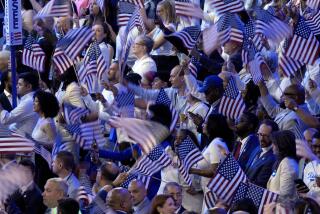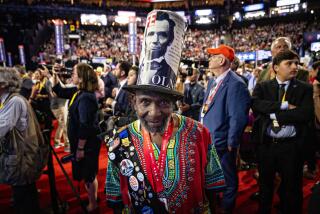FASHION : Just for You in Red, White and Blue : That long-venerated object, the flag, now seems to be used freely to decorate clothing, upholstery, food and favors.
Americans have always had a love affair with the flag. And when youâre in love, you want intimacy.
Youâre not satisfied to be separated from your idol by a 10-foot pole. You want that idol portrayed on your walls, your throw pillows, coffee mugs, headbands, book bags and pasta.
Pasta? Yes, itâs out this year courtesy of FunFoods Inc. of Hoboken, N. J.: little flag-shaped riscotti in tomato red or white, ready to be served up in pasta salad at the all-American picnic. There are no blues, though. Blue food seems to gross out even patriots.
But stars and stripes on socks, undershorts, barbecue aprons and a cigarette lighter by Colibri apparently donât.
Is this a desecration of our national symbol, or what? Didnât people once go to jail for this sort of mischief?
Well, thereâs never been a restriction on stars and stripes as such--we refer you to Uncle Sam. Itâs the actual flag, or a representation of it, that is supposed to be inviolate.
But, nowadays, youâre on your honor. The flag code, approved by Congress half a century ago, explains exactly what is disrespectful in flag etiquette, including embroidering it on cushions, printing it on paper napkins or anything that will be discarded, hanging it from a ceiling, or placing anything on top of it--a la flag tablecloths.
At American Eagle Flag Co. in Ventura, co-owner Carol Lanshe painstakingly hands out an official code with each flag that leaves the store--but she thinks that some customers donât take time to read it.
âWhen somebody comes in and orders a flag to cover a ceiling of a whole room, we canât stop them from doing that, or we canât stop them from covering a chair with it. But the flag of any nation should be respected,â she said.
âIf we think that they just donât know, we say, âWell, it really isnât a good thing to do with a flag.â â
But no one will arrest Lansheâs customers for sitting on Old Glory. Flag desecration laws, distinct from the flag code, are no longer enforced. Since their trial by fire through flag burnings, and their failure on the grounds of First Amendment rights, the flag police have retired.
This is a positive thing in many eyes. But it leaves us drifting in a patriotic taste swamp without a paddle--jostled by rafts of red, white and blue wares.
Such goods can be seen as either allegiant or camp.
âItâs kind of shocking to have somebody wear (the flag) or put it on a bar stool or a table cover,â said Mari Womack, professor of cultural anthropology at Cal State Northridge.
âIn a sense, itâs disrespect, but, in another sense, itâs a playful negotiation of the meaning that the flag has,â she said. âI donât think itâs necessarily true that people who do it are being disrespectful. I donât think itâs necessarily lack of taste. I think itâs irreverent, if you can draw a line between the two.
âBut the fact is, âYankee Doodle Dandyâ is irreverent. So there is something very American about the whole thing.â
In this view, the flag isnât disgraced.
âThe flag hasnât lost its meaning,â she said. âIts meaning is the United States and all its grandeur, humiliation, generosity--all those things. When they put it on themselves, they are inverting that and bringing it down home. . . . They are not changing the meaning at all.â
In fact, most of the flag-inspired goods we found locally look pretty innocent. Shirts, vests and hats in red, white and blue generally escape overt flagginess. And the household goods seem downright homey.
Such was the feel of a collection of handicrafts at Country Cottage in Thousand Oaks. This was the largest array we found of starred and striped objects: eagles, Uncle Sams, wreaths, hearts--and an entire flag afghan. Plus, perhaps the ultimate American symbol outside of the flag itself: a red, white and blue cow.
Owner Jack Blanchard said the demand for such wares is steadily growing.
âPeople are trying to bring back something of the old-time stuff,â he said, âItâs American recognition. The way the world is today, people are beginning to realize the old basics are getting lost; theyâre looking for reality.â
He doesnât see his customers as defilers of symbols, but the reverse; heâs reassured by that.
âPeople who buy this are flag fliers,â he said, confidently.
Just for a minute, we had to check an urge to salute.


